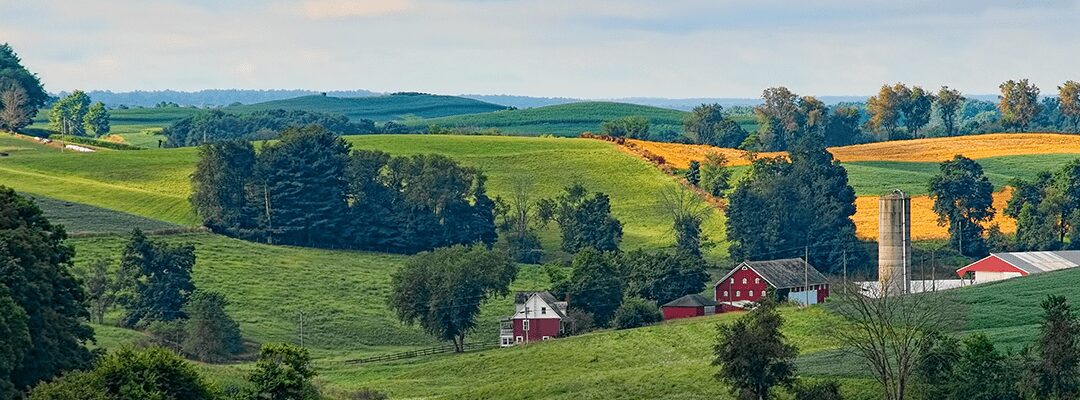Forty percent of land in the United States – or 900 million acres – is considered farmland. Corn, soybeans, and wheat may be top crops in the country, but farmland is dedicated to a variety of plants, including sunflowers, cotton, tree nuts, and rice, among others.
Given that, farming is big industry in America. In 2021, gross farm income was estimated at $510 billion and that’s expected to increase in 2022.
What’s more impressive? Nearly 90% of U.S. farms are small, with gross cash farm income less than $350,000, according to the U.S. Department of Agriculture. A very small percent (think less than one percent) are considered corporate farms.
But as we look to whether there is a future for farming in America, there are a few trends that are defining what farming – and farmland – looks like for the years to come.
Influx of Non-Farming and International Investors
The recent rush on real estate has driven up costs for homes across the country, and farmland is no different. In October, a farm in Plymouth County Iowa sold for $26,250 per acre. Experts predict that farmland prices will continue to “remain strong” – with corn-producing states in the Midwest seeing the steepest increases since the ethanol boom.
The increase in costs serves as one concern for growers and agronomic leaders, as they look at how to keep the industry alive and well for decades to come.
More non-farming investors are causing bigger concerns, however.
Media outlets have reported that billionaires are turning to farmland as a sound investment opportunity. Bill Gates, Thomas Peterffy, Ted Turner, and Jeff Bezos are just a few names that have been tied back to farmland in America.
The U.S. Department of Agriculture estimates 30% of farmland is owned by landlords who don’t farm themselves, so this isn’t a new concept. What’s new is the idea that farmland can be seen as an investment vehicle, particularly in an era where other investment options are unpredictable.
After all, growers have owned and worked the land they owned for decades; often times, the land is passed from generation to generation. And yet, these farmers, who put their blood, sweat, and tears into the land are now miffed that billionaires – who have zero experience in farming – expect this same land to produce billionaire-level returns.
Beyond billionaires, bigger concerns align with international investors who are coming to the United States to buy and farmland to produce crops for their home countries.
Like much of the world, the Middle East faces unprecedented drought-like conditions and finds that agriculture is a huge consumer of the limited water that’s available. Saudi Arabia, for instance, put a ban on high-water needs crops like alfalfa and hay in 2018.
But, for those cattle farmers and even, large-scale farmers, they need to do something.
So they come to the United States. Just in the West, foreign-owned farmland more than doubled from 2010 to 2020 – and in the Midwest? That number has nearly quadrupled.
Deteriorating Soil Quality
Prices aside, soil health concerns have plagued the agricultural industry for decades. Knowing that the amount of farmland available to us is finite, and that we must significantly increase food production to meet future population demands, many are concerned whether agriculture has the tools required to continue to produce food and resources for the decades to come.
Depending on which study you read, you’ll see a not-so-pretty forecast for the future of soil in the United States. Some scientists claim that the most fertile topsoil is disappearing at an alarming rate; while others think their mechanisms of capturing data may be unreliable.
Regardless of the debate, we are working our farmland harder than we ever have before. Many think that a century of plowing – which disturbs the natural process of decaying and living microorganisms – tied with wind and water erosion have significantly impacted top soil quality.
For decades, the belief was that adding more nutrients back to the soil – nitrogen, nitrogen, nitrogen – would get us back to square one and repair soil to where it was centuries ago.
While this can help, it doesn’t do enough to repair soil back to its natural state. Key movements like regenerative agriculture has started to make some strides (even as polarizing as it may be), but the question remains. Is it enough to keep the soil fertile enough to grow crops for another century? Or even another handful of decades?
The Future for Farming in America: Where Do We Go From Here?
Well, the future outlook for farming in America may seem bleak. We’re seeing unprecedented prices for farmland; and now, farmers have to compete with billionaires and international investors to get the land they need to support their livelihood.
On top of that? Even if you buy farmland, you’re likely to face soil quality issues.
So, what does this mean for farming in America?
It’s not all bad. There are some amazing things happening within agriculture that are preparing the industry for an even more productive future.
The best and brightest researchers are dedicated to uncovering new seed varieties that can produce better outcomes, like higher yields or plants that are more disease- or drought-resistant.
And it’s working: data shows that since 1950, the U.S. corn yield (tons per acre) has increased by 360%.
On top of that, agrisicence’s product developers are focused on finding better inputs and resources to help support crops throughout their growth lifecycle, helping to mitigate nutrient deficiencies or even the impact of weeds to plant maturity.
Technology solutions continue to help researchers and product development leaders advance the work that they are doing.
With ag drone systems, for instance, these leaders can capture high-resolution aerial imagery, which is then translated into detailed analytics via machine learning.
The result? Unprecedented insight into seed performance, crop growth and development, and even product performance. This data helps to fuel faster, and more precise critical decisions – bringing new products to market faster meeting the growing need for better performing crops.
Today, one farm can produce enough food to feed 166 people around the world. As we look at the impact of agriscience, this number will only continue to grow.
And the one thing that has kept the spirit of farming alive in America?
The passion that growers have for the work that they do. While we’ve had some scientific advancements to support the future of agriculture, food producers have more than done their part to keep the future for farming in America alive and well.
Their stewardship, for instance, has resulted in a 34% decline in wind and water erosion of cropland since 1982.
Most importantly, growers are masters at crisis management. Each season brings its own swath of challenges and issues; and for farmers, finding ways to manage the unpredictable has become second nature.
As we look at the future of farmland in America, there may be some significant challenges — but it’s nothing that our growers, agronomic leaders, and ag researchers can’t overcome.


